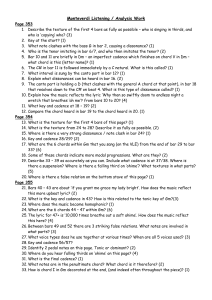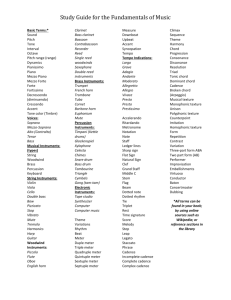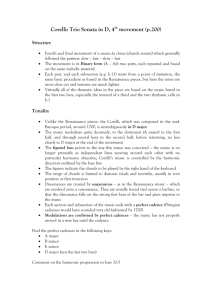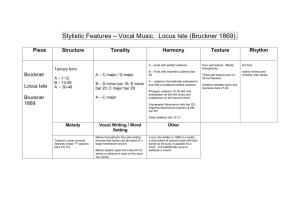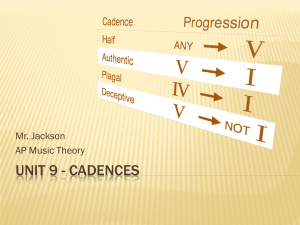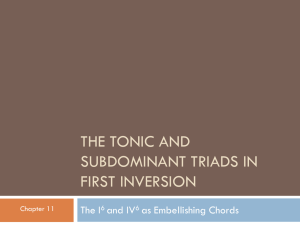Chorale Harmonization: J.S. Bach Style
advertisement
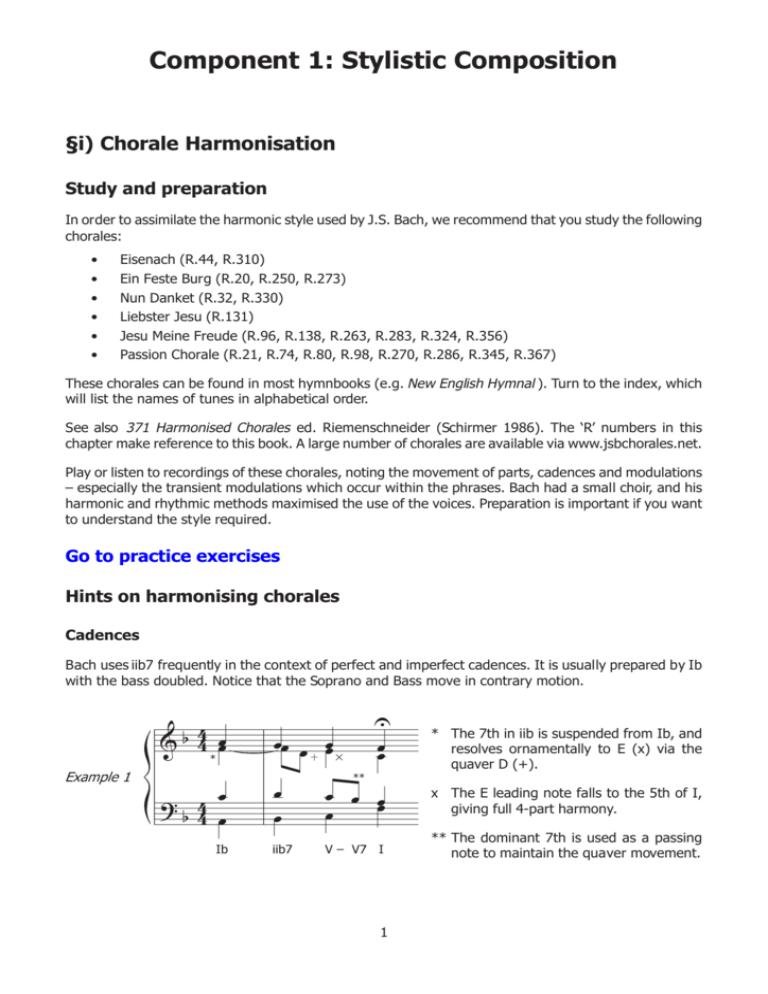
Component 1: Stylistic Composition §i) Chorale Harmonisation Study and preparation In order to assimilate the harmonic style used by J.S. Bach, we recommend that you study the following chorales: • • • • • • Eisenach (R.44, R.310) Ein Feste Burg (R.20, R.250, R.273) Nun Danket (R.32, R.330) Liebster Jesu (R.131) Jesu Meine Freude (R.96, R.138, R.263, R.283, R.324, R.356) Passion Chorale (R.21, R.74, R.80, R.98, R.270, R.286, R.345, R.367) These chorales can be found in most hymnbooks (e.g. New English Hymnal ). Turn to the index, which will list the names of tunes in alphabetical order. See also 371 Harmonised Chorales ed. Riemenschneider (Schirmer 1986). The ‘R’ numbers in this chapter make reference to this book. A large number of chorales are available via www.jsbchorales.net. Play or listen to recordings of these chorales, noting the movement of parts, cadences and modulations – especially the transient modulations which occur within the phrases. Bach had a small choir, and his harmonic and rhythmic methods maximised the use of the voices. Preparation is important if you want to understand the style required. Go to practice exercises Hints on harmonising chorales Cadences Bach uses iib7 frequently in the context of perfect and imperfect cadences. It is usually prepared by Ib with the bass doubled. Notice that the Soprano and Bass move in contrary motion. * The 7th in iib is suspended from Ib, and resolves ornamentally to E (x) via the quaver D (+). x The E leading note falls to the 5th of I, giving full 4-part harmony. ** The dominant 7th is used as a passing note to maintain the quaver movement. 1 Example 2 shows the same progression forming an imperfect cadence. Example 3 shows the same progression, but in the second chord the bass (3rd of II7) is raised by a semitone, for colour, forming a secondary 7th chord (V of V). The implied modulation to C is moving from strong to weak accents, and its effect is short-lived. Example 4 shows the use of viib – I as another form of perfect cadence. In minor keys Bach was fond of the progression shown in Example 5, forming an imperfect cadence. The melodic minor scale pattern (bracketed) formed by these bass notes produces colour, especially the C natural. * shows a rhythmic figure using E as an upper auxiliary note. 2 In Example 6, both cadences end with the same melodic pattern. The first cadence is interrupted (note that after chord V, the 3rd of chord vi is doubled), and the second cadence is perfect. Repeated notes If the opening (or any subsequent phrase) begins with repeated notes, it can be harmonised as shown in examples 7 – 9. Example 7 shows the use of a 'rolling' bass in descending motion, while the melody remains on the same pitch. Example 8 shows a 'rolling' bass in descending motion with the melody starting on Ib. The parallel thirds between the tenor and bass should not be overdone as they can produce a rather 'thick' texture. Example 9 shows chord I in three parts with the bass leaping up an octave (a strong move) to chord I in 4-part harmony – another strong effect. Of these examples, Example 9 is the preferable solution. All three examples begin on a weak beat (i.e. an anacrusis), with the same chord moving from weak to strong accents in Examples 8 and 9. See also Example 12. 3 An anacrusis beginning as follows requires a different approach: In Examples 10 and 11 we begin on the dominant chord, and the 7th (*) is used as a passing note. V7 moves to I on the strong beat, establishing the key. Repeated chords It is unusual to repeat chords exactly in chorales, except in the examples above. Example 12: When moving from strong to weak beats, repeated chords may be used. Example 13: The last chord of a phrase may be repeated to form the first chord of the next phrase. 4 Modulation Two forms of modulation occur in chorales: • Principal modulations, which are within the range of related keys and occur at cadences; • Transient modulations, again within the range of related keys but occurring within the phrase of the chorale. Here is a complete chorale with some suggestions on working. Study this example in relation to the previous pages, and then try to complete the harmony. #4 & 4 œ œ œ œ ?# 4 œ œ 4 œ œ œ œœ n œ œ œ œ œ œ œ œ œ œ œ œ U œ œ œ œ Octave leap I in Transient modulation Ib in G V7 I in 3 parts 4 parts to C major 3rd doubled # & œ U œ œ œ ?# œ œ œ œ viib # & œ ?# œ Modulation to relative minor œ U œ œ #œ œ œ A C major vib in G Vb7 I = ib in E minor E minor œ nœ œœ n œ œœ œœ A minor with Tierce de Picardie in I to give V7 in D n œœ œ U #œ œ œ #œ œ C Dim 7th in A minor œ œ œ œ œ Ib I Vb in C V7 in D œ œ œ œ œ œ œ œ i in A minor = ii in G Ib œ œ œ œ * e A is an upward resloving appoggiatura I œ œ œ #œ œ Modulation to the dominant œ n œ œ # œ # œ # œœ I œœ œ œ * œ œ œ œ œ œ œ . œ œj œ œ œ œ œ œ œ œ I Ib in C V = IVb in G Ib œ œ œ V7 B A The Tierce de Picardie is the major third, introduced into cadential (tonic) chords in a minor key. B This could be a diminished 7th in E minor. C False relations between phrases are acceptable. 5 U œ Return to tonic œœ œ Vb7 in G œ I Principal modulation If the • • • chorale is in the key of G major, the related keys are: the tonic (G major) and its relative minor (E minor); the dominant (D major) and its relative minor (B minor); the subdominant (C major) and its relative minor (A minor). U̇ Some modulations will be 'expressed' – i.e. the accidentals of the new key will occur in the melody line, as in Example 14. Example 14 # & 44 œ œ U ˙. # & 44 œ œ U ˙. iib7 V7 in G Example 15 iib7 V7 in G I I œ œ œ #œ œ œ œ œ œ œ œ œ Ib iib V7 in D I U ˙ iib V7 I in E minor Example 15 shows an 'implied' modulation to E minor. The melodic shape clearly indicates this; it cannot be treated as an interrupted cadence in G major as the F #s (leading note of G major) fall. Transient modulation These are more difficult to spot. They occur within phrases and may move from strong to weak beats or from weak to strong. They are short – usually no more than 2 chords, normally dominant or dominant 7th to tonic, and often occur in an inverted form. e.g. Vc7 – Ib or Ia Vb7 – Ia Vd7 – Ib Sometimes these modulations are totally 'implied'. Here are some examples – remember the tonic key is still G major (see related keys above). Example 16 # 4œ & 4œ ? # 44 œœ œœ œ œœ n œ œœ œ œ œ œ #œ œ œ œ #œ Vb7 i A minor œ œ nœ Vb i E minor œœ œ œ œ etc. ivb The two modulations in Example 16 are to A minor and E minor. The G natural and D natural passing notes add colour but also lead to E minor and the key to follow. 6 Example 17 # & 43 # œœ œœ œœ œœ œ N œœ œ œœ œœ œ # œœ œ œœ œ ? # 3 # œœ œ 4 V7 ib B minor œ œ # œœ V7 Ib D major œ œ Vb7 i A minor U ˙˙ .. #˙. ˙. iib7 V E minor Example 17 shows 'transient' modulations rather overworked, ending in an imperfect cadence in E minor. Use of the diminished 7th Note that the diminished 7th moves to V7 or I. Whilst it may occur within a regular phrase (often replacing V7), it can also make a dramatic start to the final phrase. Example 18 # 3 & 4 œœ œœ b œœ œ œ œ œ ? # 43 œ œ * U ˙˙ .. œœ œ œœ œ œœ œ #œ œ œ œ œ œ ˙. ˙. Example 18 shows the diminished 7th (*) used for colour in the tonic key. Example 19 # 4 œ & 4 nœ ?# 4 œ 4 #œ * œ œ œ #œ œ œ œ œœ œ œœ œ #œ œ œ ** œ œ œ U ˙˙ .. ˙. ˙. Example 19 shows the diminished 7th (*) used as the first chord of the last phrase in A minor. Notice IIb7 with the #3rd at **. 7 General points 1. The bass line The 'rolling' bass, as shown in Examples 7, 8 and 9, is a characteristic of chorales, and should feature in your workings but not be overdone. When approaching cadences the bass line is 'directional' – i.e. it moves quite often by step before reaching the cadence. See Examples 1, 2, 3, 6 and 19. 2. Unessential notes Unessential notes are the 'core' of movement in chorales, and Bach makes full use of them all, including ornamentally resolved suspensions as in the progression iib7 – V7. The dominant 7th used as a passing note is a strong feature. See Example 1. Try to spread the use of unessential notes across the parts; remember that too many such notes will 'thicken' the texture, and it will lack clarity. Again, study the chorales mentioned at the beginning of this chapter. 3. Crossing of parts Crossing of parts is allowed, but should be restricted to the alto and tenor parts in writing for SATB. When crossing parts, the purpose must be to preserve the 'line' or 'direction' of a voice part. The voices should cross completely, rather than for just one note. The actual point of crossing should form a concord: # & 44 œ Example 20 ?# 4 4 œ œ œ œ œ œ œ œ œ œ œ œ œ œ œ œ etc. This would of course be clearer if written in vocal or open score, where each part would have its own stave. 8 Practice exercises 1. e.g. Harmonise the following phrase taken from a chorale melody, in four different ways. (One possible answer is given.) 4 & b 4 # œœ œœ bœ ? 4 b4 œ œ œ n œœ œœ œ œœ * ** œ œ œ œ œ *** ˙œ #œ œ œ ˙ Dim 7th ib in G minor i iv7 V IVb in D minor Transient modulation F major to D minor a b 4 &b 4 œ œ œ œ œ ˙ œ ? b 44 œ œ œ œ œ #œ œ 4 &b 4 œ œ ? b 44 ? 4 b4 4 & b 4 œœ d œ G minor 4 &b 4 œ c ii œ B b major ? 4 œœ œ b4 œ Vc7 in C nœ œ ˙ œ nœ œ iv œ œ ** iib7 in F major = ivb7 in D minor *** i in D minor = ii in C major œ u A minor V ˙ U œ nœ œ œ œ œ œ u œ œ œ œ ˙ #œ œ œ œ œ œ #œ œ 9 vi in F major = i in D minor U œ imperfect in F major * I œ G minor * œ œ u * U œ œ E minor nœ U œœ U œ œ u imperfect in D minor The whole phrase in D minor, with diminished 7ths at *. 2. Complete this chorale in the style of J.S. Bach, as indicated. Write for SATB in short score. 4 & 2 ˙˙ ˙˙ ˙ ? 42 ˙ &˙ ˙ ˙ ˙ ˙ ˙ ˙ # ˙˙ ˙ ˙ ˙ transient modulation to G major ˙ ˙ œ œ A ˙ c ˙ ˙˙ ˙ ˙ ˙ ˙ n œœ œœ & ˙ ?˙ ˙ ˙ ˙ u ˙ ˙ œ ˙ ˙ #˙ œ ˙ ˙˙ u ˙˙ ˙ 'Vom Himmel hoch' ˙ U ˙ ? d U̇ œ œ e ˙ ˙ U ˙ B In the examination, you could be asked to complete either the section bracketed A or the section bracketed B. i. Look at the whole chorale, especially the harmony of the first phrase. ii. Work out the related keys: • C major / A minor • G major / E minor • F major / D minor iii. Look carefully at the crotchets: are they accented or unaccented passing notes? iv. Consider the possibilities of the cadences: • Cadence c could be perfect in C or imperfect in A minor • Cadence d could be imperfect in C or perfect in G • Cadence e is the final cadence, and must therefore be perfect in C v. Now look for transient modulations in each phrase. vi. Can the last phrase begin on a diminished 7th in G? vii. In phrase 3 the C # in the bass indicates a move to D minor. Is this followed by a move towards C major? If so, the cadence ending the phrase would be in G major! viii. In the last phrase there is a transient modulation to D minor, which leads naturally to the final cadence in C major. The penultimate note in this cadence could benefit from two crotchet chords i.e. iib – V7 or iib7 – V7. ix. The first cadence in bar 2 is a perfect cadence in C major. In order to avoid hearing a further cadence in C it would be better to end the second phrase with an imperfect cadence in the relative minor. 10 3. Study this chorale carefully, noting the similarity of the first and last cadences, using iib7 and V7: can this occur again in other cadences? Bach's solutions to these phrases are given on the next page – look at these after you have worked out the harmony. 4 & b 2 ˙˙ ˙ ? 4 ˙ b 2 ‘Jesu Meine Freude’ ˙˙ ˙œ # œ ˙˙ œ œ ˙ ˙ œ œ ˙ ˙ w &b œ œ ˙ w˙ # ˙ ˙ ˙ ww ˙. œ W .. ˙ ˙ ˙ ?b ˙ œ w ˙ ˙˙ ˙˙ œ n˙ ˙ .. ˙ n˙ ˙ ˙ B œ nœ w w ?b & b ˙˙ œ œœ A ˙ w ˙ ?b œ œ œ œ w & b ˙. ˙ ˙ œ œ n œœ œ ˙ œ ˙ ˙ œ œ w w ˙ œ œ ˙ # ww ˙ ˙ ˙œ œ n ˙˙ œ œ ˙ œ ˙˙ w˙ ˙ ˙ ˙ ˙ 11 #˙ œ ˙ œ W W #W W ˙ Bach's solutions 4 œ œ ˙˙ b & 2 œ œ ˙ ? 4 ˙ b 2 & b ˙˙ ? ˙˙ b 4. ˙. ˙. ˙œ œ ˙˙ # ˙ ˙ ˙˙ n ˙˙ ˙ œ œ ˙ ˙ ˙˙ ˙œ ˙œ ˙˙ ˙˙ ˙ ˙˙ œ œ W W ˙˙ œ B ˙ ˙ œ U̇ œ œ ? ## 4 4 Use continuous # & 44 œ b œ W œ W œ˙ n œ ˙ ˙ w˙ ˙˙. ˙ œ ww ˙ ˙ ˙˙ #˙ ˙ ˙ ˙ ˙ ˙˙ œ ˙ œ œ œ ww ˙ ww #w w Complete these chorale fragments for SATB, writing in short score. ## 4 & 4 œ œ œœ œ a A ?# 4 œ 4 œ œ œ œ œ œ œ œ #œ œ U œ œ œ œ̇ œ ˙ œ œœ œ œ ˙ u movement in the bass, except where notated. œ œœ œ œ œ œ œ ˙ U ˙ u̇ 12 R.256 œ R.152 ### 4 œ & 4 c d ? # # # 44 #4 & 4 œœ œ ? # 44 œœ œœ œ œ œ #œ œ œ œ œœ œ œ œ œ. #œ J U̇ œ œ œ #œ n˙ U œ œ œ œœ # œœ œ . œ œ U œœ œ œ œ ˙œ œ ˙ œ œœ œ œ œ œ œ œ u R.83 œ œ œ x x U ˙ R.65 œ œ œ œ œ œ œ œ œ œ œ x x = accented passing note b & b b 44 œ e ? b b 44 œ b #### 4 & 4œ f œœ œœ œ bœ œ œ œ bœ œ nœ nœ ˙ œ œœ œ œœ œ œ ? # # # # 4 œœ œ œœ 4 U œ œ œ œ bœ u U̇ Œ œ œ œ ˙ u Œ #œ x œ œ œ œ œ œ bœ nœ œ œ œœ œ œœ n œœ œ œ. U ˙. R.108 œ œ U œ R.85 j œ x = accented passing note 13 * = diminished 7th chord in the following exercises. g & 44 œ œ œ œ ? 4 # œœ 4 h # & 44 # œœ œ œ j œœ œ œ œ œ bœ * œ œ œ œ œ #œ ?# 4 œ œ œ œ 4 œ i ˙ & b 44 œ œ œ œ œ œ nœ œ œœ R.21 œ # œœ U ˙. R.340 œ # œœ œ * U ˙ R.30 * * œ ? 4 œ œ œ. b4 #œ J œ b & b b 44 b œœ b œ œ ? b b 44 œ b œœ b œ U œ œ œ U ˙. * œ U œ œ ˙ œœ nœ * nœ * œ nœ œ œ œ nœ œ bœ bœ U̇ œœ œ bœ b œœ n œ n˙ 14 œ œ œ œ œ œ œ œ bœ nœ U ˙ R.113 The following eight chorales (Exercises 5-12) will give you further practice. In each case, bracketed sections marked A and B indicate the kinds and lengths of extracts which might be used in the DipMusLCM examination. 5. b4 & b 4 œœ U bb ˙ & # ˙ .. A ? b b œ œ ˙. ? b ˙. b u b &b ˙ œ œœ n œ œ œ œ œœ ? b b 44 œœ œœ n œœ # œ œœ œœ U ˙. #˙. œ œ 'Auf meinen lieben Gott' œ œ œ œ œ ˙. ˙. u U ˙œ œ œ œœ œ u B œ œ œœ œ œ œ œ œ œ œ œ œ œœ # œ œœ œ œ œ #œ u nœ œ U œ œ œ œ œ œ nœ œ œ #œ œ nœ nœ œ 15 U œ u œ œ œ œ œ œ œ œ œ nœ #œ bœ ˙ U œ u 6. b 4 & b b 4 œœ œ œ œœ U œœ˙ œœ œ œœ ˙ œœ 'Meinen Jesum lass ich nicht' œœ œ œ œ œ œ œ œ œ ˙˙ œ œ ? b 4 œ œ œ œ œ œ œ œ bb 4 u U bb ˙ & b ˙ A b &bb œ œ ? b bb œ œ ? b b n œœ œ b œ œ œœ U œ œœ˙ œ U n ˙˙ œœ œ œ œ œ œ nœ œ œ nœ U ˙ œ œ œ ˙ œœ œ œ œœ œ n œ œ n œ œœ œ ˙œ . œ œ œ œ œ œ n œ œ œœ œ œ œ n œ œ œ œ œ œ œœ œœœœ œ œ œ œœ b œœ ? b b ˙˙ b u b œ &bb œ œ œœ œ œœ B œœ œ bœ œ bœ œ œ bœ œ œœ œœ b œ œ œ 16 œ œ œ œ œœœ œ œ U ˙ œ J 7. 'Liebster Immanuel, Herzog der Frommen' # 3 ˙ & # 2˙ ˙ ˙ ? ## 3 ˙ 2˙ & ## ˙ #œ œ ˙ ˙ & ˙˙ ? ## ˙ ˙ B ## ˙ & ˙ ? ## ˙ ˙˙ ˙˙ ˙˙ ˙ #˙. ˙˙ ˙ ˙ ˙˙ ˙˙ ˙ ˙ ww ˙ ˙ œ œ #˙. œ ˙ œ œ ˙ 17 ˙˙ ˙ ˙ ˙ œ ˙ ˙. ˙ .. # ww .. u .. ˙ ˙ U ww # ˙˙ ww u U ww .. #w. w. u U ˙˙ œ ˙˙ u U ww .. ˙ ˙ # ˙˙ w˙ œ œ œ ˙. ˙ ww œ˙ œ œ œ ˙ ˙ ˙ ˙ ˙ ˙˙ œ œ ˙ ˙˙ ˙ ˙ n ˙˙ œ ˙ ˙. ? # # ˙˙ ## ˙ ˙ œ˙ œ # œœ œœ # # ˙˙ A ˙˙ # ˙˙ . # ˙ œ ˙˙ 8. ### 4 Œ & 4 œœ œœ œ œ œ œ œœ œœ ? # # # 44 Œ œ œ ### ˙ & œ U œ œ ˙˙ œ œ œ œ œ ? # # # œœ œ œ # œœ # œœ œœ n œ n œœ œ .. ˙ ˙ u .. ### U & ˙ Œ œ ? ### Œ #œ B ### Œ & ? ### Œ œœ œ œ œ U ˙ #˙ œœ A Œ ˙˙ u Œ œ œ Œ œœ œ œ œ œ œ #œ œ œ œ n œ œ # œ # œ œœ n œœ œ œ œ œœ œ œ œ œœ J œ. œ œ œ œœ . œ œ œ œ œ Œ œ œœ n œ œ œ œ J J nœ œ œ œ #œ œ nœ œ œœ 'Herr, wie du willst' œœ œ œ œ œ. œ œ J 18 œ œ œ œ œ œ nœ œ. œœ œ œ U ˙œ U œ ˙ J ˙ ˙ u œ u 9. 'Alle Menschen müssen sterben' # 4 & # 4 œœ ? # # 4 œœ 4 & ## œœ. œ œ œœ œ œ œ œ œ œ œ U j œ œ ˙ j œ œ .. œ & œ œ #œ U ˙ ? ## œ œ œ œ ˙ œ œ œ œ u œœ œ œœ œ œœ œœ œ #œ œ œ œœ œœ j # œ œ œ œ U œ œ œ œœ œœ . .. c* œ. œ œ œ œ œ ? ## ## œ œ œ œ œ œœ A ? # # œœ œ œ . œ ˙˙ œ u # & # œ. œœ . œ œ œ U œœ j œ œœ œ œ #œ U œ œ œ J ˙ œ œ u̇ U d* œ B œ œ c* Complete melody line and bass part. d* Complete melody line, alto and tenor parts. 19 œ œ œ œ œ ˙ u 10. bb 4 & b b 4 œœ œœ œœ nœ U œœ œ ? bb 4 œ bb 4 bb & b b ˙œ œ ˙œ œ œ œ œ œ œ. œ œœ J œ œ œœ œ œ u ? b b b œ˙ œ œ b b & b bb œ œœ œœ œœ œ œ œ u œ œ œ œ œ œ œ œ œ œ œ d œ bœ œ œ œ œ œ œ U œ ˙ f œ œ œ œ œ œ œ œ œ œ œœ œ œœ c ? bb bb ? bb b œ œ b œ œ u œœ œ A œ œ œ bb &bb U œœ 'Nun ruhen alle Wälder' bœ œ œ At c and e continue the melody, alto and tenor parts. At d and f add alto, tenor and bass parts. 20 ˙. u B e œ œ œ œ œ œ œ œ œ nœ œ U œ 11. 'O Haupt voll Blut und Wunden' # 4 & # 4 œœ œ œ ? # # 4 œœ 4 œ U ## . & ˙˙ . & œ œœ œ œœ œ ˙œ œ œ œ œ œ œ œœ .. ? # # ˙˙ . . u ## œœ œ œ œ œ œ œ œ œ œ œ B U ˙. œ œ œ f œ œ œ œ u At c and e continue the melody, alto and tenor parts. At d and f add alto, tenor and bass parts. 21 ˙ œ u e œ #œ œ #œ œ d œ ## ? ## # œ œ œ œ œ. œ J œ œ œ œœ œ œ œ œ #œ œ œ u ? ## & œ œ œ œ œ œ œ A c .. œ U œœ œ #œ œ œ U ˙. œ 12. 4 & 2 ˙˙ ˙˙ ˙ ?4 ˙ 2 ˙˙ & ˙œ œ ˙˙ ˙ ?˙ # ˙˙ ˙˙ ˙ ˙ œ œ ˙ œ˙ œ b œœ œœ ˙ ˙ ˙ ˙ ˙˙ ˙ ˙ ˙ d & ?˙ ˙ ˙ ˙˙ ˙ ˙ n œœ U ˙˙ ˙˙ ˙œ œ ˙ ˙ œ nœ ˙ u ˙ ˙ ˙ ˙ u At c continue the melody, alto and tenor parts. At d continue the alto, tenor and bass parts. 22 œœ ˙˙ U ˙ ˙ ˙˙ ˙ ˙ u 'Vom Himmel hoch' ˙ œ œ ˙ œ œ A c ˙ œ œ œ ˙ ˙ #˙ œ ˙ ˙ U ˙

